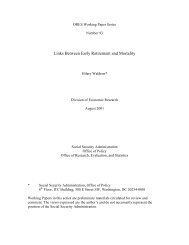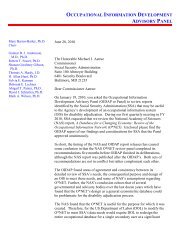Download entire publication - Social Security
Download entire publication - Social Security
Download entire publication - Social Security
Create successful ePaper yourself
Turn your PDF publications into a flip-book with our unique Google optimized e-Paper software.
from DB to DC pensions is accelerated under theU.K. scenario, only 7 percent of first-wave boomers,8 percent of second-wave boomers, 9 percentof third-wave boomers, and 11 percent of last-waveboomers would see their retirement incomes increase.There are many more who would lose under theU.K. scenario—12 percent of first-wave boomers,18 percent of second-wave boomers, 22 percent ofthird-wave boomers, and 26 percent of last-waveboomers. Boomers in high socioeconomic groupsare most likely to win and lose because they are thepeople with pension benefits in the baseline scenariothat may potentially be frozen. For example,12 percent of last-wave boomers in the highest incomequintile are projected to be winners, compared withonly 6 percent of their counterparts in the lowestincome quintile; and 48 percent of last-wave boomerswith the highest incomes are projected to be losers,compared with only 8 percent of those with the lowestincomes (Chart 1). All in all, 60 percent of last-waveboomers in the highest income quintile will experiencea change (either positive or negative) in theirper capita family income because of the change inpension schemes. Note that the percentage affectedis higher than the 54 percent of last-wave boomersin the highest income quintile who are projectedto have family DB pension benefits in the baselinescenario (see Table 4). This apparent discrepancyoccurs because some individuals (especially thosewith higher income) wait until after age 67 to retireand collect their DB pensions. These individuals willappear as winners in Table 7 because the increase inDC retirement account income has not yet been offsetby the lower future DB pension income. Also, weassume workers who are not vested under the baselinescenario become immediately vested under a pensionfreeze, thereby gaining DB pension income. Manyof the people who would gain pension coverage as aresult of the freeze under the U.K. scenario may havepreviously changed jobs or dropped out of the laborforce at a relatively young age because of a disabilityand have not become vested under the baseline.It is also worth noting that among last-waveboomers, there are about four times as many losersthan winners in the highest income quintile, butonly slightly more losers than winners in the lowestquintile. High-income workers are significantlymore likely than low-income workers to lose underthe U.K. scenario because they are more likely to beChart 1.Percent of last-wave boomers who win and lose income at age 67 between the baseline and U.K.scenarios, by income quintilePercent50454048WinnersLosers35302526253020191510511 108612 13120AllBottomquintile2ndquintile3rdquintile4thquintileTopquintileIncome quintileSOURCE: Authors' computations of MINT5 (see text for details).NOTE: Projections exclude individuals with family wealth in the top 5 percent of the distribution. Winners and losers are defined as having atleast a $10 change in income between the baseline and U.K. scenarios.14 <strong>Social</strong> <strong>Security</strong> Bulletin • Vol. 69 • No. 3 • 2009








